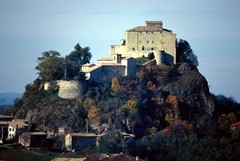Municipality of Canossa.
The Castle of Rossena and the Tower of Rossenella
After visiting and reliving the historical vicissitudes of Matilda at Canossa, the itinerary following the Grand Countess’s story wends its way towards the nearby castle of Rossena. Sited to defend the castle of Canossa, it rises proud and mighty on a tall volcanic rock of a reddish hue.
Conceivably, this is the most impressive fortress of the entire area associated with Matilda since, unlike other castles which have been turned into residences, it maintains its original appearance as a defensive bastion. It has been suggested that the castle was built in 950 by Matilda’s great-grandfather, Atto Adalberto, while other sources cite Boniface of Canossa, the Duke of Tuscany, Matilda’s father, who left it to the church of Reggio as payment for property received by title of emphyteusis. The earliest layout featured an isolated keep whose structure, currently much reduced, became part of the main building and was surrounded by a first quadrilateral wall, now no longer standing. The castle may only be reached by an ancient lane that starts from the small medieval village below.
Beyond the grand entrance portal, we enter a large courtyard where the early church of San Matteo sits. Climbing the steep staircase, the castle entrance leads to various rooms and other spaces hewn out of the rock, once used as storerooms, dungeons, cisterns and cellars. The courtyard at the top, surrounded by the sentry patrol paths, grants an incredible panorama of the Enza valley and the Apennines, all the way from Bismantova to Canossa and Mount Ventasso. It is possible to visit certain rooms and also a small chapel where fascinating seventeenth-century frescoes have come to light. Rossena’s role as a defensive bastion continued for centuries. After the Canossa family, in the fourteenth century it passed to the Da Correggio who kept it on, through thick and thin, until 1613, when it became part of the Dukedom of Parma and Piacenza under the Farnese, and later, in 1847, after the death of the duchess Marie Louise, was added to the Dukedom of Modena and Reggio. Currently owned by the Dioceses of Reggio Emilia, in the year 2000 it underwent major restoration work to mark the Jubilee.
The Tower of Rossenella
Opposite the castle, and just a stone’s throw from Rossena, perched high on a rock is the Rossenella watchtower, known also as Guardiola. This is reached by following a breathtaking path while its interior may also be visited after the painstaking 2007 restorations. The tower dates back to the XII-XIII century. The perfect alignment of the building with respect to the cardinal points is no accident, indeed, the long sides face due north-south and the short sides east-west. This allowed the soldiers on guard duty to make the most of the heat and light of the sun which could penetrate the interior through the loopholes and windows even during the harshest winters. Inside, the tower was split into three levels. The ground floor had no direct access from the outside and was normally used as a storeroom accessible from the first floor, which, in turn, could only be reached via a retractable staircase, as was the custom in the Middle Ages to make towers inaccessible and more easily defended against enemy attack. The first and second floor served various functions, both for accommodation and defence.
